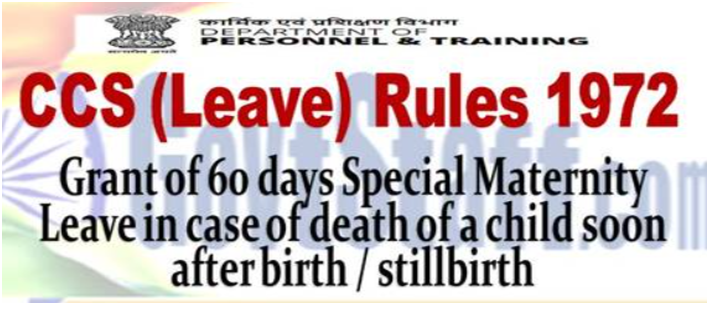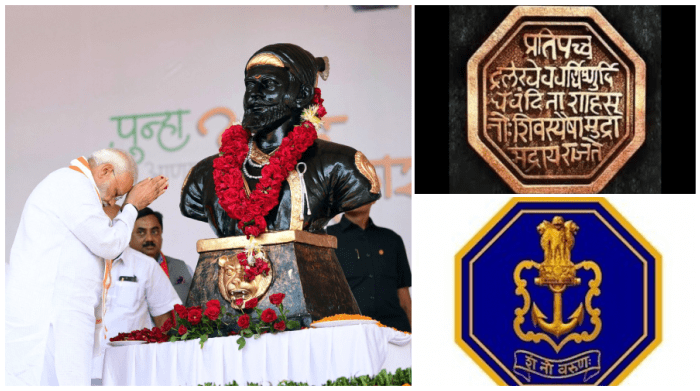60-day special maternity leave (GS Paper 2, Governance)

Why in news?
According to a recent order issued by the Department of Personnel and Training (DoPT), all female central government employees will be entitled for 60 days special maternity leave in case of death of a child soon after birth.
Why this decision has been taken?
- The matter has been considered in consultation with Ministry of Health and Family Welfare.
- The decision has been taken keeping in view the potential emotional trauma caused due to stillbirth or death of a child soon after birth, which has a far-reaching impact on the mother’s life.
- The DoPT said it has been receiving several references/queries requesting for clarification pertaining to grant of leave/maternity leave in case of death of a child soon after birth/stillbirth.
Key Highlights:
- In case a maternity leave has already been availed by a female central government servant and her leave continues till the date of expiry of child soon after birth/stillbirth, the maternity leave already availed till death of the child may be converted into any other kind of leave available in her leave account without insisting for a medical certificate and a special maternity leave of 60 days may be granted from the date of expiry of child soon after birth/stillbirth.
- In case the maternity leave has not been availed by a female central government servant, 60 days of special maternity leave may be granted from the date of expiry of child soon after birth/ stillbirth.
Who can avail the benefit?
- The condition for death of a child soon after birth may be defined as up to 28 days after birth.
- A baby born with no signs of life at or after 28 weeks of gestation may be defined as stillbirth.
- The benefit of special maternity leave shall be admissible only to a female central government servant with less than two surviving children and for child delivery only in an authorised hospital.
- The authorised hospital is defined as government hospital or private hospital empanelled under the Central Government Health Scheme (CGHS).
- In case of emergency delivery in non-empanelled private hospital, production of emergency certificate is mandatory.
- These orders shall be applicable to government employees appointed to the civil services and posts in connection with the affairs of the Union of India in terms of Rule 2 of the Central Civil Services (Leave) Rules 1972 with effect from the date of issue of this order, it said.
New Navy ensign inspired by Chhatrapati Shivaji
(GS Paper 3, Defence)
Why in news?
- Recently, the Prime Minister unveiled the Indian Navy's new Ensign 'Nishaan' at the commissioning of India's first indigenous aircraft carrier, INS Vikrant.
The new ensign dropped the St George’s Cross and incorporates the royal seal of Chhatrapati Shivaji Maharaj.

Background:
- Over the years, Naval ensign was changed many times. The first ensign of 1947 was changed in 1950. Later, it underwent changes during 2001, 2004 and 2014.
- The erstwhile Indian Naval Ensign included the National Flag in the upper left canton, red vertical and horizontal stripes and a golden yellow state emblem superimposed on the intersection of the red stripes.
- The national motto ‘Satyamev Jayate’ engraved in Devanagari script was included underneath the State Emblem. This White ensign has been flown by all formations, ships and establishments of the Indian Navy till September 1, 2022.
- After the need was felt for a transition, design inputs were invited from the entire Navy. Responses poured in from Naval personnel from all formations and various hierarchies, reflecting enthusiasm for the endeavour, and have helped in developing the new design of the Naval ensign.
New White Ensign:
- The White Ensign identified nation-wide with the Navy, now comprises of two main constituents - the National Flag in the upper left canton, and a Navy Blue - Gold octagon at the centre of the fly side (away from the staff).
- The Octagon is with twin golden octagonal borders encompassing the golden National Emblem (Lion Capital of Ashoka underscribed with ‘Satyamev Jayate’ in blue Devnagri script) resting atop an anchor; and superimposed on a shield.
- Below the shield, within the octagon, in a golden bordered ribbon, on a Navy Blue background, is inscribed the motto of the Indian Navy ‘Sam No Varunah’ in golden Devnagri script.
- The design encompassed within the octagon has been taken from the Indian Naval crest. The fouled anchor, which is also associated with colonial legacy, has been replaced with a clear anchor underscoring the steadfastness of the Indian Navy.
What does the Navy Blue Colour Indicate?
- The Navy Blue colour of the above octagonal shape depicts the blue water capabilities of the Indian Navy.
- The twin octagonal borders draw their inspiration from Seal of Chhatrapati Shivaji Maharaj, one of the prominent Indian kings with a visionary maritime outlook, who built a credible Naval Fleet that earned grudging admiration from European Navies operating in the region at the time.
- The octagonal shape also represents the eight directions (four cardinal and four inter cardinal), symbolising the Indian Navy’s global outreach. The Octagon stands for good fortune, eternity, renewal and draws positive energy from all directions.
Way Forward:
- The new Naval White Ensign is thus, rooted in the glorious maritime heritage of India, as well as reflective of our Navy’s present day capabilities.
- Formations, ships and establishments of the Indian Navy would be adopting the new Naval ensign, as also the new distinguishing flags, car flags and masthead pennants.
Decline in young population causing decline in student enrolment: NCERT
(GS Paper 2, Education)
Why in news?
Recently, an Educational Survey Division (ESD) of NCERT, releases a report titled. ‘Projection and Trends of School Enrolment by 2025'.

Role of enrolment:
- Enrolment is a function of population. If there is less gap between enrolment figure and child population of the respective age or age-group then growth in enrolment will be directly proportional to the growth in the child population of that respective age or age-group.
Basis of Data:
- It has taken into account the National Achievement Survey (NAS) conducted by the NCERT and figures of the annual Unified District Information System for Education (UDISE) data.
- The study considered NAS reports from 21 states where the population was more than 5 million in the 2011 Population Census of India, saying there is much fluctuation in the data of the North Eastern states and some statistics are not available.
Key Highlights:
- It has projected that the overall enrolment in schools will have declined by more than 14 per cent by 2025, beginning from 2011, with the enrolment of girls expected to decline by over 2 per cent more than that of boys.
- The enrolment of scheduled caste students would remain unchanged for the next 5-10 years, while the number of students from scheduled tribe will face stagnation after 2023-24.
- The report said that enrolment is a function of population, so a decline in the child population in the age groups of 6-11, 11-14, and 14-16 years is reflected in the enrolment at each stage.
Stage-wise projections:
- The growth in enrolment at the primary stage continued up to the year 2011. After 2011, the enrolment has declined and this will continue till 2025. During the period from 2011 to 2025, total enrolment will decrease by 14.37 per cent whereas enrolment of boys and girls will decrease by 13.28 per cent and 15.54 per cent, respectively.
- At the upper primary stage, the enrolment of boys, girls and the total percentage started to decline from 2016. During this period, enrolment decreased by 9.47 per cent (in total), 8.07 per cent (boys) and 10.94 per cent (girls).
- Similarly, decline in enrolment was also recorded at the secondary stage but here the decline started from 2020.
- In the social groups, scheduled castes and scheduled tribes, the decline in school enrolment pattern was very similar to India's enrolment pattern.
Significance:
- The NCERT report has studied trends since 1950, when the country had 2,171 schools with 2.38 crore students.
- The study is an outcome of the PAC programme's objective of projecting the school enrolment in the country from 2016-2025.
- It will help in identifying the possible trends in school enrolment for boys and girls as well as the marginalized groups of society for all the states and UTs in the country.
Way Forward:
- The analysis can give insights and help the government plan future education policies.
- This forms the basis for many investment decisions like opening of new schools, upgradation of existing schools, employment and deployment of teachers and the provisioning of infrastructure.
Over 99% of Indians breathe air exceeding WHO's health-based guidelines
(GS Paper 3, Environment)
Why in news?
- Recently, Greenpeace India released a report titled “Different Air Under One Sky”.
- It says that over 99 per cent of India’s population is breathing air that exceeds the World Health Organisation’s (WHO’s) health-based guidelines with respect to PM2.5.
What is PM2.5?
- PM2.5 refers to fine particles which penetrate deep into the body and fuel inflammation in the lungs and respiratory tract, leading to the risk of cardiovascular and respiratory problems, including a weak immune system.
Key Findings:
- The greatest proportion of people living in India are exposed to PM2.5 concentrations more than five times the WHO annual average guideline.
- The 62 per cent of pregnant women in the country live in the most polluted areas, compared to 56 per cent people in the whole population.
- As per the report’s annual average PM2.5 exposure analysis, the region with the highest exposure to pollution in the country is Delhi-NCR.
It listed older adults, infants and pregnant women as the most vulnerable groups who are “exposed to worse air.

Recommendations:
- The report said the government “must introduce a robust air quality monitoring system” across the country and “make the data publicly available in real time”.
- A health advisory and ‘red alerts’ for bad-air days should also be issued so that the public are able to take necessary steps to protect their health, and polluters would be required to reduce emissions to protect the environment.
- It said the current National Ambient Air Quality Standards (NAAQS) is “insufficient” and “needs immediate revision”.
- The Central Pollution Control Board must set a process of revision of NAAQS based on scientific evidence. The government must ensure the implementation of all the planned activities under the National Clean Air Programme (NCAP).
- It further stressed that there is an urgent need to make NCAP more transparent, comprehensive and stronger.
Way Forward:
- The people are already paying a huge price for the air pollution crisis and it is taking a massive toll on healthcare systems.
- People are being forced to breathe in polluted air and are faced with a terrible health crisis. They can’t afford any delays to act on this crisis.





